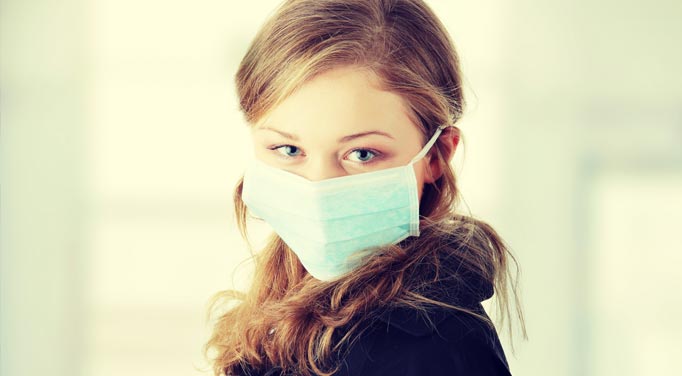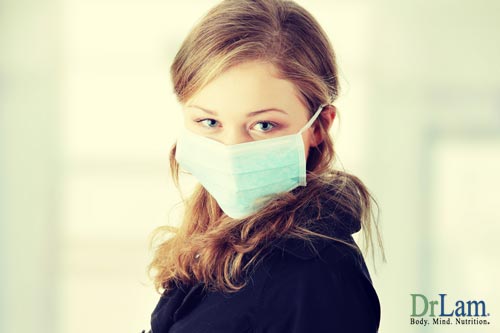 Swine influenza (also called swine flu or H1N1) refers to influenza caused by any strain of the influenza virus endemic in pigs (swine). What many don't know about about H1N1 is that it is rare in humans and common in swine. Those who are highest at risk usually have occupational contact with swine, such as people who work in close proximity with pigs. Normally the swine flu does not jump across species from swine to human. What is interesting about H1N1 is that in rare occasions, Swine influenza virus mutates into a form able to pass easily from human to human. In humans, the symptoms of about H1N1 are similar to those of influenza-like illness. Common symptoms include fever, sore throat, chills, muscle pains, coughing, general malaise, and headache. The 2009 outbreak has shown an increased percentage of patients reporting diarrhea and vomiting.
Swine influenza (also called swine flu or H1N1) refers to influenza caused by any strain of the influenza virus endemic in pigs (swine). What many don't know about about H1N1 is that it is rare in humans and common in swine. Those who are highest at risk usually have occupational contact with swine, such as people who work in close proximity with pigs. Normally the swine flu does not jump across species from swine to human. What is interesting about H1N1 is that in rare occasions, Swine influenza virus mutates into a form able to pass easily from human to human. In humans, the symptoms of about H1N1 are similar to those of influenza-like illness. Common symptoms include fever, sore throat, chills, muscle pains, coughing, general malaise, and headache. The 2009 outbreak has shown an increased percentage of patients reporting diarrhea and vomiting.
What makes the 2009 flu outbreak in humans significant is due to a new strain of influenza A virus subtype about H1N1. This subtype derives in part from avian influenza, human influenza, and two separate strains of swine influenza. Unlike ordinary swine flu, it passes with great ease from human to human. Fortunately, only mild symptoms are encountered and the infected individual usually makes a full recovery without requiring medical attention and without the use of anti-viral medicines. Those who are immuno-compromised, such as older adults, infants, and those with weak constitution and adrenals may be more prone to this flu and need to know more about H1N1 to safeguard their health.
Because the non-specific symptoms, a detail history is important in the diagnosis process. Physicians should consider swine influenza infection in the differential diagnosis of patients with acute febrile respiratory illness and those who have traveled in Mexico during the 7 days preceding their illness onset. A diagnosis of confirmed swine flu requires laboratory testing with a respiratory sample which usually means a simple nose and throat swab.
The most common method of transmission between humans is through coughing or sneezing and people touching something with the virus on it and then touching their own nose or mouth. What we know about H1N1 or swine flu is that it cannot be spread by pork products, since the virus is not transmitted through food. > What we do know about H1N1 is that it is contagious, especially during the first five days of the illness. In children, the contagious period can last up to ten days.
What we know about H1N1 is how to prevent the spread of the virus. Standard good hygiene and preventive techniques should be used. This includes frequent washing of hands with soap and water or with alcohol-based hand sanitizers, especially after being out in public areas.
Anyone with flu-like symptoms, that could potentially be about H1N1, such as a sudden malaise, fever, cough or headache should stay away from work or public transportation and should see a physician for further testing.
While there is no treatment for the swine flu, the use of Tamiflu (oseltamivir) or Relenza (zanamivir) for the treatment and/or prevention of infection with swine influenza viruses can be considered. When thinking about H1N1, it should be noted that most infected with the virus make a full recovery without requiring medical attention or antiviral drugs. Antiviral drugs, if needed, work best if started soon after getting sick (within 2 days of symptoms).
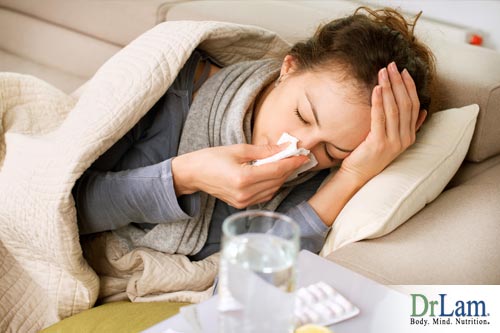
If you are sick with a fever that is accompanied by a fever, runny nose, sore throat, diarrhea, nausea, vomiting, coughing, and lethargy, and are thinking it's about H1N1, consult a health-care provider.
It is important to remember one of the things about H1N1 is that the vast majority of infected people do not die from this virus. The key determinant is the immune status of the individual. A body with a strong immune system is able to fight the H1N1 virus. The infected person may have some symptoms, but complete recovery can be expected with supportive therapy. On the other hand, if the immune system is sub-optimal, the body will easily succumb to this virus, potentially resulting in death.
What is important to know about H1N1 is the key to prevention or overcoming swine flu lies in having a strong immune system. Let us look now at how the immune system works.
In our immune system there are two important elements called T- and B-lymphocytes.
B-lymphocytes make and distribute antibodies in our bodies. There are many different forms of antibodies. They are classified into five major classes: IgA (immunoglobulin A), IgD, IgG, IgM, and IgE. Each class has its own function. They work together to ensure that all foreign bodies are destroyed.
T-lymphocytes are in charge of the cell's immunity. They act as a command post from which most orders for the immune system flow, as well as stimulating macrophages and B-lymphocytes. T-lymphocytes are the pillars for protecting the body from diseases such as bacterial infections, strong viruses, fungi, cancer, and parasitic infections.
These T-lymphocytes are assisted by a group of T-helper cells. They help to control various white blood cells by issuing chemical codes known as cytokines. Some examples are interleukins and interferons. T-helper cells coordinate the efforts of white blood cells and destroy unwanted substances.
Our bodies also manufacture T-suppressor cells to slow down the destructive activities of cytokines from other white blood cells. This is an important function, as it serves to protect the host. The correct ratio of T-helper to T-suppressor cells is crucial. It maintains a balance between the aggressive actions to destroy bad cells while protecting the good cells.
Today, biology's greatest achievements have brought about much research into some of the immunity boosting agents derived from natural sources.
Perhaps the best known natural immunity booster agent is vitamin C. Spanning 50 years, thousands of studies have repeatedly shown the benefit of vitamin C in aborting the flu.
What we know about H1N1 is that vitamin C intake may be able to prevent its onset. Vitamin C is a water-soluble antioxidant. Animals that can make vitamin C internally have their production increase by 5-10 times when under stress. Humans cannot produce this vitamin and therefore, must get it from external sources. Fortunately, it is found abundantly in fruits and vegetables such as citrus fruits, papayas, tomatoes, and Brussels sprouts. Supplementation of 1 gram of vitamin C and 200 mg of vitamin E daily for 16 weeks resulted in significant increases in immune function. When the body is exposed to stress, the amount of vitamin C needed is greatly increased. Stress can be emotional, or physical. 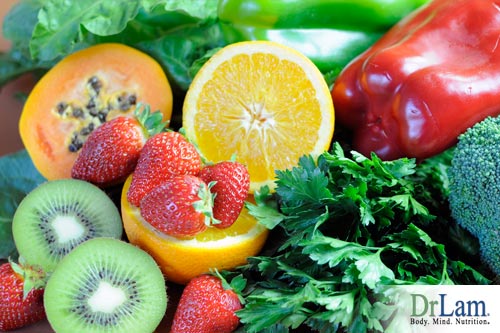 Stressors can include respiratory illness, influenza, death of a loved one, or physical trauma. The common denominator of stress control resides in the adrenal glands. It is here that the body's response to stress is modulated and control by a variety of hormones. The most important of this anti-stress hormone is cortisol. Vitamin C plays a key role in the production of cortisol. When learning about H1N1 effects on the body, prevention, and ways to aid in recovery, vitamin C may be able to assist you.
Stressors can include respiratory illness, influenza, death of a loved one, or physical trauma. The common denominator of stress control resides in the adrenal glands. It is here that the body's response to stress is modulated and control by a variety of hormones. The most important of this anti-stress hormone is cortisol. Vitamin C plays a key role in the production of cortisol. When learning about H1N1 effects on the body, prevention, and ways to aid in recovery, vitamin C may be able to assist you.
Vitamin C works to built immunity and overcomes infections through a variety of pathways. As an excellent electron donator, it helps to neutralize toxins released by bacteria and virus. As an important catalyst in the production of cortisol, it helps the anti-inflammatory response and strengthens adrenal function.
Research on vitamin C is so well known that many people probably know at least two or three effects of Vitamin C. The effects of Vitamin C are wide ranging. They have been postulated to immunize against cancer, save arteries by driving up HDL, raise immunity by increasing production of lymphocytes, reverse the biological clock by increasing the white blood cell level in elderly, improve sperm, restore male fertility, combat gum disease, suppress high blood pressure, and regenerate Vitamin E and glutathione. Studies have found that reduced concentrations of this vitamin are associated with impaired immune function.
During an infection, the body's requirement for vitamin C can easy go up 10 to 20 fold or more. Having a sufficient level of vitamin C in the body is therefore critical to help produce anti-inflammatory hormones including cortisol, prevent catabolic state from worsening through collagen synthesis, boost immune function to fight infection, overcome opportunistic infections, and neutralize systemic toxins from bacteria and viruses. Without a doubt, high dose vitamin C fortification should therefore be a cornerstone and foundation of any infectious disease recovery program.
Vitamin C comes in many forms. Each form of vitamin C has its own properties and characteristics. Ascorbic acid tends to be more acidic and "spiky", while buffered vitamin C tends to be a bit more gentle. Some people do well with ascorbic acid, but many develop gastric irritation and diarrhea at high doses. Many therefore cannot take ordinary vitamin C or buffered vitamin C in high doses. Most vitamin C commercially available are derived from corn sources, while some are from food sources. Food source vitamin C may raise blood sugar level, while those who have corn allergy may find corn source vitamin C intolerable. Vitamin C itself has adaptogenic properties as well as stimulatory properties. Manifestation of these characteristics is highly dependent on the degree of adrenal fatigue and the body's constitutional make-up.
Vitamin C is available in various oral delivery systems as well, from capsules, tablets, liquid, intravenous, powder, to effervescent forms. Absorption of regular oral vitamin C from the GI tract to the hepatic circulation varies from 5-18%. A bowl tolerance level is usually reached from 5,000- 10,000 mg, where diarrhea occurs.
Because over 80% of ordinary oral vitamin C passes through the gastrointestinal track unabsorbed, ultimate bio-availability to the cell is severely limited. This has been a great challenge. The electron donation and thus adrenal support, toxin-reversal and anti-bacterial effect of vitamin C can only be relied upon when administered in very high doses.
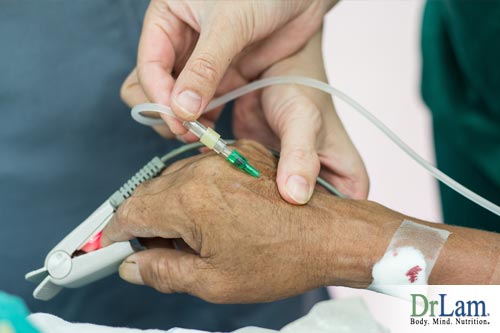 Up until recently, intravenous administration remains the best option to deliver high dose vitamin C to the cells This is an expansive and time consuming process.
Up until recently, intravenous administration remains the best option to deliver high dose vitamin C to the cells This is an expansive and time consuming process.
In recent years, the advance of nanotechnology and liposomal encapsulation technology offers a significantly enhanced oral liquid delivery system with superior absorption from the small intestine. This cutting edge liposomal delivery system dramatically improves bio-availability and is by far the best oral form of vitamin C delivery system available. Liposomal delivery system is ideally suited for the out-patient setting because high dose can be administered easily orally and inexpensively. Because absorption occurs at the small intestine and the stomach is bypassed, gastric irritation is minimal if any. Diarrhea is also significantly reduced because most is absorbed and does not remain in the GI tract.
Therapeutic Dosage: Commercially available liposomal vitamin C, such as LipoNanoTM C, is a good choice. The dosage varies from person to person, but most do well with 2,000 to 5,000 mg a day. Those taking other forms of oral vitamin C should consider a dosage 3 to 5 times higher.
Vitamin E is a critical fat-soluble membrane stabilizer. If deficient in Vitamin E, increased free-radical-induced damage to red-blood-cell membranes can result. Studies have found that Vitamin-E supplementation improves immune response.
Therapeutic Dose: 400-800 IU a day. Always take the natural form of vitamin E (d-tocopherol, as opposed to the synthetic dl-tocopherol form) as this form is best absorbed.
This mineral affects many aspects of immune health. A zinc deficiency may increase susceptibility to a variety of pathogens, thus making it more difficult to fight infection. Zinc is essential for normal development and functioning of neutrophils and natural killer cells. It also helps with production of antibodies and T cells in addition to other white cells.
Therapeutic Dosage: 50 -100 mg a day. Long-term supplementation at therapeutic dosage level is not recommended.
Cat's Claw is also called "una de gato" in Spanish. It can be found on trees in the rain forests of the Andes Mountains, particularly in Peru. It is a 100 foot woody vine.
Compared with Echinacea, Golden Seal, Astragalus, and Siberian Ginseng, Cat's Claw is far superior in its anti-bacterial and immune building properties.
Cat's Claw enhances the immune system in a general way. The unique alkaloids found in Cat's Claw enables white blood cells to swallow and digest harmful organisms in the body. The most immunologically active alkaloid is called isoteropodine or isomer A. Cat's Claw has been proven to increase the production of leukocytes and T4 lymphocytes, thus blocking the advances of many viral diseases.
Cat's Claw also has excellent antioxidant properties that help prevent the hardening of the arteries and heart disease. Long ago, way beyond the times of our forefathers, the bark of the root was used as the medicinal part. Today, the bark from the vine is used.
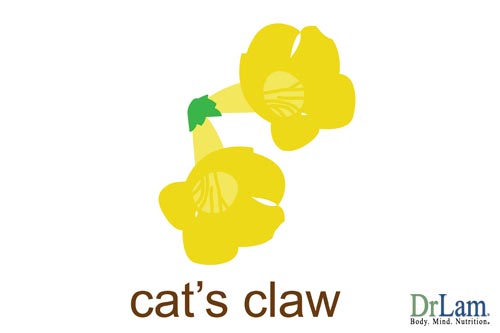 Therapeutic Dosage: One cup of tea to be drank 3 times a day or 1 to 2 ml twice a day in mixture form. In the form of dry standardized extract, 20 to 60 mg should be taken daily. The amount should be increased to 2 to 6 grams a day for those in advance cases.
Therapeutic Dosage: One cup of tea to be drank 3 times a day or 1 to 2 ml twice a day in mixture form. In the form of dry standardized extract, 20 to 60 mg should be taken daily. The amount should be increased to 2 to 6 grams a day for those in advance cases.
As Cat's Claw may cause the immune system to reject foreign cells, anyone with organ or tissue transplants should not take it. If you are suffering from autoimmune illnesses, multiple sclerosis or tuberculosis, you should also avoid it. Cat's Claw is not suitable for pregnant women and children below 2 years old. Those people on blood thinners such as aspirin or warfarin should use it carefully as it may also block platelets from forming blood clots, thus making the treatment less effective.
This is a relatively newcomer in antioxidant arena. It only made its maiden appearance in the mid 1980s. Despite being a relatively new compound, successful studies have indicated that it can treat illnesses caused by a virus, retrovirus, bacterium or protozoan. Influenza, the common cold, meningitis, Epstein-Barr virus (EBV), encephalitis, herpes I and II, human herpes virus 6 and 7, shingles, HIV/ARC/AIDS, chronic fatigue, hepatitis B, pneumonia, tuberculosis, gonorrhea, malaria, dengue fever, bacteremia, severe diarrhea, blood poisoning and dental, ear, urinary tract and surgical infection can also be treated by using the olive leaf extract.
Whether you are old or young, olive leaf can revitalize your energy and rejuvenate your health. It helps to sustain stamina during exercise. If you feel that your life is stressful, you are prone to colds and viruses, start taking olive leaf. You may have more to gain in the long-term. Some people have reaped the benefits of olive leaf such as improved psoriasis, normalization of heart beat irregularities and less pain from hemorrhoids, toothaches and chronically achy joints.
The active ingredient in olive leaf is called Oleuropein. It is made from an ingredient found on olive trees that protect the trees against insects and bacteria. This ingredient is an iridoil, which is a structural class of chemical compounds found in plants. It is found abundantly in olive oil and olive trees, and is actually the bitter material that is removed from the olives when they are processed.
Research and extensive medical studies confirm that olive leaf is anti-viral because it can damage the virus and bacteria in an infected person. It also has other healing properties such as:
Olive leaf extract can boost our immune system by increasing phagocytes in white blood cells. This leads to a destruction of foreign bacteria and viruses that are literally gobbled up by the phagocytes. The benefits of olive leaf extract are something to consider when learning about H1N1 prevention.
Therapeutic Dosage: The standardized extract is ideal because it contains at least 20 percent of active ingredients. The recommended dosage is 500 mg to 2,000 mg a day.
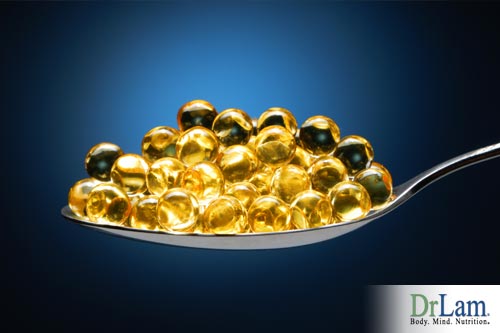 Fish and its oil, once mocked by doctors as useless remedies are now fulfilling claims beyond folk medicine's wildest dreams by emerging as one of the most potent dietary supplements. Fish oil contains a high dose of omega 3 fatty acids that helps to protect the body against a long string of diseases due to its immune boosting function.
Fish and its oil, once mocked by doctors as useless remedies are now fulfilling claims beyond folk medicine's wildest dreams by emerging as one of the most potent dietary supplements. Fish oil contains a high dose of omega 3 fatty acids that helps to protect the body against a long string of diseases due to its immune boosting function.
Studies have shown that an intake of moderate amounts of long-chain omega-3 PUFAs Eicosapentaenoic acid (EPA) and Docosahexaenoic acid (DHA) (less than 10% of fat from n-3 PUFA or less than 1 gram EPA plus DHA per day to humans) can enhance immune functions, including lymphocyte proliferation/activation, natural killer-cell activity, and macrophage activation and should be considered when thinking about H1N1 prevention and recovery.
Therapeutic Dosage: Most high potency fish oil provides 1,000 to 1,500 mg of fish oil with about 300 to 500 mg of EPA and 200 to 300 mg of DHA per 1000 mg capsule. One to 3 capsules a day is recommended. Fish oil in large doses has a blood-thinning effect. People who are on blood thinning medicine such as coumadin should not consume excessive amounts of fish oil.
There are altogether 100,000 types of mushrooms. About 700 types can be eaten. Another 50 types are poisonous while another 50 have medicinal effects. Some mushrooms are very pretty but almost all medical mushrooms look tough and woody. We can never judge a mushroom by its appearance. Medical mushrooms are often unused in cooking due to their bitter taste.
Medical mushrooms are famous for immunity boosting and can be considered when thinking about H1N1 prevention. Centuries ago, people had already began using them as tonics and folk medicines for curing diseases.
Today, scientists are conducting much research and experiments on mushrooms. It is very clear that each mushroom has its own unique immune boosting properties. Maitake, Reishi, Shitake, and Agaricus are excellent choices to build the immune system. Mushrooms have a high content of fiber. Be careful not to overeat, as it may be difficult for the digestive system.
No mushroom can perform magic or miracles. In today's commercial business, enterprising mushroom vendors will try to promote their own as the most effective. Their prices may also vary. The consumer should be cautious and only buy from reputable and reliable suppliers.
Let us look at some of these medical mushrooms.
This Japanese mushroom is nicknamed "hen of the woods", as it grows in clusters that resemble the tail feathers of a hen. Animal studies have extensively analyzed this mushroom's effect on cancer cells. When dried mushroom powder was mixed into the animal's food, it could control and stop cancer when used orally.
Like all other mushrooms, Maitake's action is that of a host defense potentiator. However, it reigns over the rest of the mushrooms in the inhibition of tumor cells. The beta-glucan present in maitake mushrooms activates the natural killer cells of our immune system. The active immune building compound is called Beta-D-glucan. Beta-D-glucan is made up of a huge sugar molecule. Within this molecule are little sugar molecules chained together to bind amino acids. These sugars stimulate the immune system by activating immune cells such as macrophage and helper T-cells. They also increase the antibodies' effectiveness in producing a better response to bad cells.
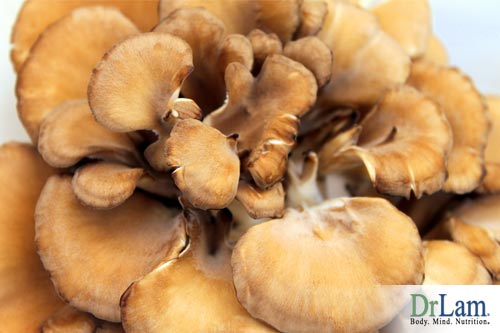 Therapeutic Dosage: 2 to 8 grams of whole mushroom powder a day is needed. Exercise caution when buying maitake mushroom powders as there are many forms on the market. Always look for the genuine ones. Also be careful not to take too much as mushroom powder contains fiber that is hard to digest. A large intake will result in an upset stomach.
Therapeutic Dosage: 2 to 8 grams of whole mushroom powder a day is needed. Exercise caution when buying maitake mushroom powders as there are many forms on the market. Always look for the genuine ones. Also be careful not to take too much as mushroom powder contains fiber that is hard to digest. A large intake will result in an upset stomach.
The extract form of maitake mushroom is best. In the market, many suppliers do not disclose the extraction ratio. However, do note that a 100 mg of 8:1 extract is the same as taking 800 mg of dry powder. The higher the extraction ratio, the less you have to take and you will still get the same good results. Good quality extracts run from a 4:1 to 8:1 extraction ratio. However, they are usually more expensive than the powder form. But spending this amount of money may be worthwhile in the long run.
Maitake extracts when taken with 2,000 mg of Vitamin C is even more effective than maitake taken alone.
Reishi mushrooms have a gorgeous dark, shiny reddish-orange cap. However, an attractive surface doesn't always tell the inside story.
In ancient days, the Chinese and Japanese used this mushroom to treat liver disorders, hypertension, and arthritis. It is ranked by the Chinese as one of the most potent medicinal plants in history.
Reishi has proven anti-allergic, anti-inflammatory, anti-viral, anti-bacterial, and antioxidant properties. In vitro experiments show that Reishi can help fight tumors. A protein, which is isolated from Reishi called Ling Zhi-8, can reduce the risk of transplant rejections.
Reishi is hard, bitter, and difficult to swallow. You can consume either dried Reishi grounded into tea or in capsule form. Reishi has been proven to protect the liver, as a tonic for the heart and central nervous system, lower cholesterol, and prevent allergic responsiveness. It can also increase the production of Interleukin-1 & 2 and stop tumor growth.
According to Japanese scientist Dr. Fukumi Morishige, Reishi performs a better function when combined with high doses of vitamin C. As polysaccharides in the Reishi are big molecules that are difficult to absorb, Vitamin C helps to break them down into smaller molecules called oligoglucan. The body can easily absorb these. As such, Vitamin C increases the bioavailability of Reishi and enhances its immune boosting effect.
Therapeutic Dosage: Take 150 to 900 mg of concentrated Reishi extract daily. The standardized extracts give the best results. These are usually more expensive but they are genuine and up to the mark.
The most common edible, best-studied form of mushroom with the greatest proven therapeutic powers is the shitake mushroom. We can buy these mushrooms at Asian markets or at the local health food stores. This type of mushroom has lots of meat. They taste delicious and are often served as a dish or as an ingredient in a variety of dishes at home or in restaurants. Its roots originated during the Ming Dynasty in 1368 A.D. During this period, it was esteemed as a longevity tonic.
Shitake contains cortinelin, which is a strong antibacterial agent. It also produces an extract containing lentinan, which stimulates the production of T lymphocytes and natural killer cells.
Therapeutic Dosage: Take 2 to 6 grams daily in powder, or 400 to 800 mg in high potency standardized extract .
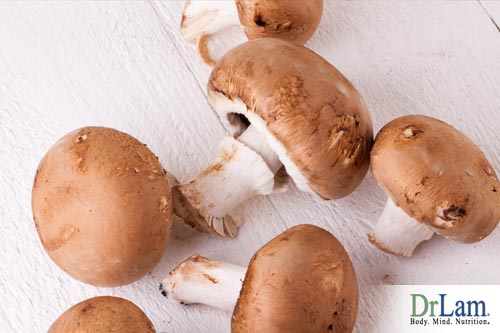 This is one of the most potent of medical mushrooms. It was first noticed about 30 years ago when two researchers from Penn State University visited Piedade and discovered that the natives were very healthy, with very low rates of disease, and that a disproportionately high number enjoyed longevity. The polysaccharide contained in ABM vitalizes production of interferon and interleukin. This effect indirectly functions to destroy or prevent the proliferation of cancer cells. ABM is less promoted than the other mushrooms, but its therapeutic efficacy should not be overlooked.
This is one of the most potent of medical mushrooms. It was first noticed about 30 years ago when two researchers from Penn State University visited Piedade and discovered that the natives were very healthy, with very low rates of disease, and that a disproportionately high number enjoyed longevity. The polysaccharide contained in ABM vitalizes production of interferon and interleukin. This effect indirectly functions to destroy or prevent the proliferation of cancer cells. ABM is less promoted than the other mushrooms, but its therapeutic efficacy should not be overlooked.
Therapeutic Dosage: Take 1-3 grams daily in powder, or 400-800 mg in standardized extract form.
This is a rare and precious tonic found on the high plateaus of southwestern China 3,000-4,000 meters above sea level. It is also called caterpillar fungus and comes in the form of a fine light beige powder. In Chinese, Cordycep means "summer plant, winter worm." They grow by infecting insect larvae or mature insects with spores that germinate before the cocoon is formed. The fruiting body of the Cordycep grows from the dead host. GCI's Cordycep is a potent vegetarian strain grown on organic brown rice.
This tonic promotes phagocytosis of peritoneal macrophages, enhances the function of the reticuloendothelial system and reduces cholesterol levels.
The ancient Chinese swear by this mushroom. For more than 1,000 years, it has been used to strengthen health and enhance immunity after a bout of chronic illness. It is also historically known to treat lung disease, impotence, and restore renal functions. Cordyceps are excellent for boosting cardiovascular health, lung, kidney, and sexual functions. Eating this mushroom can also help you to stay young and energetic.
It is ideal for convalescing patients. It helps to boost appetite, enhances blood functions, respiratory tract problems, and susceptibility to colds or flu.
Therapeutic Dosage: Take 1 to 3 grams of powder a day. Up market cordyceps are very expensive and can cost over $1,000 per pound. Today, developed cultured cordyceps using bioengineering processes have significantly lowered the cost.
Take the standardized extract with 2:1 extract ratio that contains at least 20 percent of the active ingredient, polysaccharide. A capsule in this form will yield about 140 mg of polysaccharide. The normal dose is 1 to 2 tablets per day. In more serious illnesses, the dosage should be increased two or three fold.
Excessive stress leads to a catabolic state, with reduced insulin sensitivity, reduced glucose utilization, increased blood sugar, which can lead to diabetes and greater chances of infection. Stress also reduces secretory IgA (the main cellular defense factor), natural killer (NK) cell and T-lymphocyte activity. This leads to increased chances of getting infections such as Herpes, yeast overgrowth, and viral infections.
Reduce stress as much as possible to boost your immune system.
Regular exercise helps us fight off infection by boosting the immune system. In a study, 112 male and female subjects were divided into four groups. One group followed a supervised exercise plan twice a week; the second ate enriched fruit and dairy products daily; the third followed both the exercise and diet schedules and the last followed neither schedules.
 By studying skin tests that measured immune responses to certain pathogens, the investigators discovered that those who exercised had stronger responses compared to the other groups. Blood vitamin concentrations also rose in the enriched food group but the foods did not appear to boost the immune system when thinking about H1N1.
By studying skin tests that measured immune responses to certain pathogens, the investigators discovered that those who exercised had stronger responses compared to the other groups. Blood vitamin concentrations also rose in the enriched food group but the foods did not appear to boost the immune system when thinking about H1N1.
There is little doubt that exercise is a great immune enhancer.
A low-sugar diet is ideal to boost immunity. Sugar slows down the activity of white blood cells. Avoid ice cream, table sugar, cakes, sodas, and cookies as much as possible if you want your immune system to be in tip-top condition.
When thinking about H1N1 or any other illness, the chances of you getting sick on a high sugar diet is far greater than if you smoke. An aggressive reduction in sugar intake is advisable if you are interested to prevent viral infections. If you have to eat dessert, consume it during the day and not just before bedtime. Sugar, taken before bedtime, also reduces growth hormone release and increases cortisol, the "bad" hormone. Treat sugar as a drug; stay as far away from it as possible.
Specifically, the consumption of lean meats (such as wild game or non-grain fed, free-range domesticated animals), fish (such as cold water fish, like salmon, which contains omega 3 fatty acids), above ground vegetables, whole fruits, raw nuts and seeds, legumes, and whole grain cereal are recommended. Notably, absent from this diet, are dairy products, refined cereal, refined grains (neocarbs), trans fat (margarine and fried foods) and concentrated sweets
Tomatoes are one of the richest sources of lycopene, a plant compound that is a potent free-radical fighter. In a study, it was shown that those who ate a tomato-rich diet for three weeks sustained 38 percent less free-radical damage to their infection-fighting white blood cells than they did during a three-week period on a tomato-free diet. Interestingly, lycopene is more available when the tomato is cooked.
These are rich in glutathione, an important component of the immune system. Glutathione defends white blood cells against free-radical attacks. It also stimulates the immune system to release macrophages which in turn engulf and destroy foreign invaders.
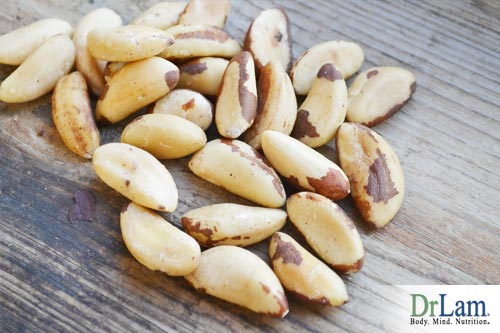 Brazil nuts are full of selenium, a mighty mineral that functions as a component of glutathione and boosts the activity of white blood cells. A daily intake of just 100 micrograms of selenium (the amount in one Brazil nut) reduced the risk of respiratory infections in elderly volunteers over a two-year period, outperforming more famous antioxidants like Vitamins A, C and E. Do make sure you take raw and unsweetened Brazil nuts.
Brazil nuts are full of selenium, a mighty mineral that functions as a component of glutathione and boosts the activity of white blood cells. A daily intake of just 100 micrograms of selenium (the amount in one Brazil nut) reduced the risk of respiratory infections in elderly volunteers over a two-year period, outperforming more famous antioxidants like Vitamins A, C and E. Do make sure you take raw and unsweetened Brazil nuts.
Garlic is one of the most versatile and widely used herbs in the world. It can kill viruses responsible for colds and the flu and stimulate infection-fighting immune cells. One clove a day is recommended. If you cannot take garlic, try garlic pill.
